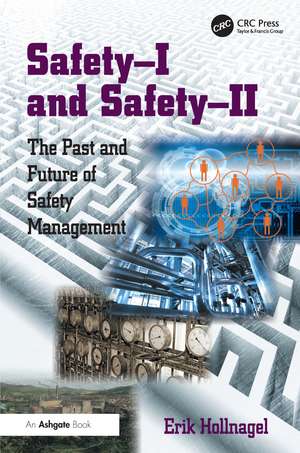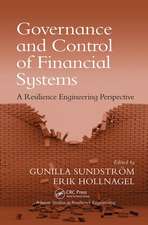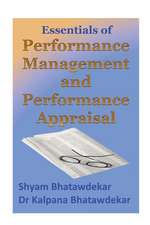Safety-I and Safety-II: The Past and Future of Safety Management
Autor Erik Hollnagelen Limba Engleză Paperback – 28 mai 2014
| Toate formatele și edițiile | Preț | Express |
|---|---|---|
| Paperback (1) | 377.49 lei 6-8 săpt. | |
| CRC Press – 28 mai 2014 | 377.49 lei 6-8 săpt. | |
| Hardback (1) | 1110.74 lei 6-8 săpt. | |
| CRC Press – 28 apr 2014 | 1110.74 lei 6-8 săpt. |
Preț: 377.49 lei
Nou
Puncte Express: 566
Preț estimativ în valută:
72.24€ • 78.44$ • 60.68£
72.24€ • 78.44$ • 60.68£
Carte tipărită la comandă
Livrare economică 23 aprilie-07 mai
Preluare comenzi: 021 569.72.76
Specificații
ISBN-13: 9781472423085
ISBN-10: 1472423089
Pagini: 200
Ilustrații: Includes 30 b&w illustrations
Dimensiuni: 156 x 234 x 11 mm
Greutate: 0.29 kg
Ediția:New ed.
Editura: CRC Press
Colecția CRC Press
ISBN-10: 1472423089
Pagini: 200
Ilustrații: Includes 30 b&w illustrations
Dimensiuni: 156 x 234 x 11 mm
Greutate: 0.29 kg
Ediția:New ed.
Editura: CRC Press
Colecția CRC Press
Public țintă
Academic and Professional Practice & DevelopmentNotă biografică
Erik Hollnagel (Ph.D., psychology) is Professor at the Department of Regional Health Research, University of Southern Denmark and Chief Consultant at the Centre for Quality, Region of Southern Denmark. He is also Professor Emeritus at University of Linköping (Sweden), and Visiting Fellow of the Institute for Advanced Study of the Technische Universität München (Germany). He has since 1971 worked at universities, research centres, and industries in several countries and with problems from many domains, including nuclear power generation, aerospace and aviation, air traffic management, software engineering, healthcare, and land-based traffic. His professional interests include industrial safety, human factors, resilience engineering, systems theory, and functional modelling. He has published more than 350 papers and authored or edited 20 books, some of the most recent titles being Resilient Health Care (Ashgate, 2013), The Functional Resonance Analysis Method (Ashgate, 2012), and Resilience Engineering in Practice (Ashgate, 2011). Erik Hollnagel is also Editor-in-chief of Ashgate Studies in Resilience Engineering.
Recenzii
’Much more than a technical book. Erik’s work is a well documented journey into the multiple interactions between safety, work and human nature. A timely contribution to vindicate human beings and their variability from the one sided focus on the evils of human error. A groundbreaking look at the other story that will certainly contribute to safer and more productive workplaces.’ Dr Alejandro Morales, Mutual Seguridad, Chile ’Safety needs a new maturity. We can no longer improve by simply doing what we have been doing, even by doing it better. Dr Hollnagel brings forth new distinctions, interpretations, and narratives that will allow safety to progress to new unforeseen levels. Safety II is more than just incident and accident prevention. A must read for every safety professional.’ Tom McDaniel, Global Manager Zero Harm and Human Performance, Siemens Energy, Inc., USA ’If you want to belong to the future of safety management, Erik Hollnagel argues, you pretty much know where to stand. It is called Safety II.’ Journal of Contingencies and Crisis Management, July 2014 ’Although someone may judge from the book title that the author refers to a new methodology for managing safety, Hollnagel’s work is definitely more than this. The specific book recommends a new way of thinking and approaching safety itself, prior to attempting to manage it. The real life examples and the smooth introduction of the reader to safety related concepts, which are based on broad and solid theoretical and empirical bases, are just few of the strong points in Hollnagel’s book.’ Newsletter of the Europe Chapter of the Human Factors and Ergonomics Society, no. 2, 2014 ’While this is not a handbook for Safety-II management, Hollnagel provides an outline of the consequences of Safety-II thinking.’ Australian & New Zealand Journal of Health, Safety and Environment, vol. 31, no. 1, 2015
Cuprins
List of Figures, List of Tables, 1. The Issues, 2. The Pedigree, 3. The Current State, 4. The Myths of Safety–I, 5. The Deconstruction of Safety–I, 6. The Need to Change, 7. The Construction of Safety–II, 8. The Way Ahead, 9. Final Thoughts, Glossary, Index
Descriere
This book analyses and explains the principles behind Safety-I and Safety-II and approaches and considers the past and future of safety management practices. The analysis makes use of common examples and cases from domains such as aviation, nuclear power production, process management and health care. The final chapters explain the theoretical and practical consequences of the new, Safety-II perspective on day-to-day operations as well as on strategic management (safety culture).
















